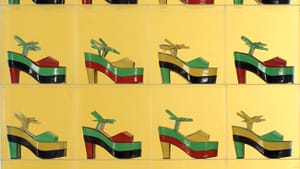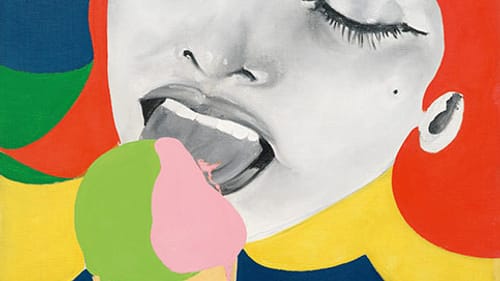Stay in the Loop
BSR publishes on a weekly schedule, with an email newsletter every Wednesday and Thursday morning. There’s no paywall, and subscribing is always free.
Boys and their toys
International Pop at the Philadelphia Museum of Art

Walking into the International Pop exhibit is like walking into a young man’s play room: women’s body parts and cultural icons derived from consumption predominate, though small collages by women are tucked in between the massive male-created works that dominate the space.
It’s an impressive exhibit spanning the world and the history of Pop Art, which emerged in the ’60s but continues today as a break from convention and formality. In this country it’s usually either a celebration or a critique of American culture; works by international artists show that the genre has functioned as political statement as well as cultural commentary around the world.
British artist Richard Hamilton wrote, “Pop Art should be popular, transient, expendable, low-cost, mass-produced, young, witty, sexy, gimmicky, glamorous, and big business.” This exhibit (a variation of a show that has appeared in other cities) shows it is all of those things, and more.
While the American rooms celebrate American culture (Jasper Johns’ Flag is unique to the Philadelphia show), the international rooms are the most compelling, offering art as political statement, art as critique of America, or religion (Argentine artist León Ferrari’s image of Christ on a jet fighter, La civilización occidental y cristiana (The Western Christian Civilization), or capitalist consumption (see Icelandic artist Erró’s Foodscape).
Women, whole or in parts
While there is no lack of women as exhibits, either whole or in parts — see, for example, Sophia Loren’s lips in Richard Hamilton’s Hers Is a Lush Situation — there is a dearth of women as creator throughout: only about 15 of the 80 artists whose work is shown are female. Belgian artist Evelyne Axell’s Ice Cream is used to promote the show — an image considered so racy that it was blocked on Facebeook for a while. Most of the work by women, however, is smaller or in media that border on craft — collage, sculpture — such as Marisol’s Dinner Date in wood, or Marta Minujin’s Mattress (Erotics in Technicolor) made from mattress fabric and foam rubber. There is even a display of shoes as art, Dalila doble plataforma, by the Argentine artist Dalila Puzzovio. Some of the women are included with a mate — is Yoko Ono in the show in her own right, or because of her connection to John Lennon?

The penultimate room in the show honors the feminine. Czech artist Jana Zelibska’s Venus, a large triptych of a woman’s form with flower breasts and a mirrored vagina, dominates the space, while Axell’s small piece is tucked into a corner. This may be a reaction to the masculine nature of art, but it also says some weird things about the feminine. Is she flat and transparent and reflecting you back to yourself?
Should art be viewed through a gendered lens? Probably not, but once you put on those glasses, it’s hard to see it any other way. When an exhibit is created, what is included is what has already been validated. Unless one checks the bias inherent in doing that, it is easy to just duplicate what has always been done.
Women have been working in the genre. Almost half of the artists in the recent Tate Modern exhibit The World Goes Pop were women, and publicity around the show focused on the women artists. The reviews, however, were mixed. It seems we want to see what we have always seen.
Any exhibit forces choices and omissions, but with our heightened sensitivity to such things, it would be good to have some awareness, or at least information, on the ignored artists who can’t be included due to space or taste.
Note: Concurrent with this exhibit are Picasso: The Great War, Experimentation and Change at the Barnes Foundation and the play Red, about painter Mark Rothko, at Studio on 3 at Walnut Street Theater.
What, When, Where
International Pop. Through May 15 at Philadelphia Museum of Art, 2600 Benjamin Franklin Pkwy, Philadelphia. 215-763-8100 or philamuseum.org.
Sign up for our newsletter
All of the week's new articles, all in one place. Sign up for the free weekly BSR newsletters, and don't miss a conversation.
 Naomi Orwin
Naomi Orwin